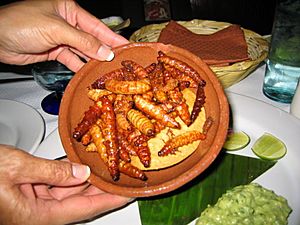Mezcal worm facts for kids
A mezcal worm is actually an insect larva that you might find in some types of mezcal. Mezcal is a traditional drink made in Oaxaca, Mexico. These larvae are usually one of two kinds: the gusano rojo (which means "red worm") or the chinicuil. The chinicuil is a type of caterpillar from the Comadia redtenbacheri moth, also known as a maguey worm. Many people think the red worm tastes better.
Why are worms in mezcal?
Even though it seems like an old tradition, putting larvae in mezcal is actually quite new. Some brands of mezcal use these larvae to add a special flavor to the drink. A whole larva is placed inside the bottle. It is usually prepared first by being soaked in pure alcohol.
The first company to start this practice was Nacional Vinicola (NAVISA) with their Gusano Rojo mezcal. Andres Paniagua and Jacobo Lozano were the people who first thought of adding larvae to mezcal. Today, several other brands, like Patron, also do this.
Other kinds of worms
There's another kind of "worm" you might hear about in relation to agave plants. This is the larva of a weevil called picudo del agave, or Scyphophorus acupunctatus. This insect is also known as the agave snout weevil. It can infest certain types of yucca and maguey plants. These weevil larvae are not related to the edible maguey worms (which are actually moth or butterfly larvae) found in central Mexico.
The agave snout weevil is a pest that can cause serious harm to agave plants. It eats the plant from the inside, which can kill it. Even a few of these weevils can carry harmful bacteria that infect the plant and lead to its death. Sometimes, up to 40% of a maguey plant harvest has been lost because of these weevil infestations. Scientists are working to develop types of agave plants that can resist these infections.
Picudo larvae can be roasted and eaten. They are a special food item sold in markets in southeastern Mexico during certain seasons.
See also
In Spanish: Gusano de maguey para niños


